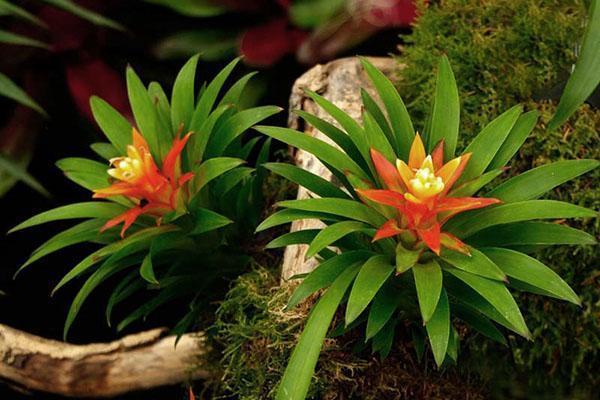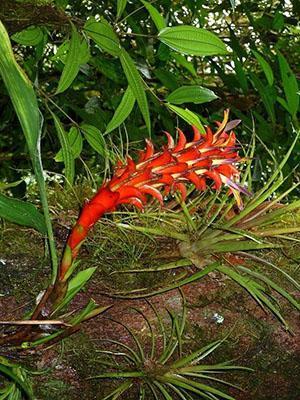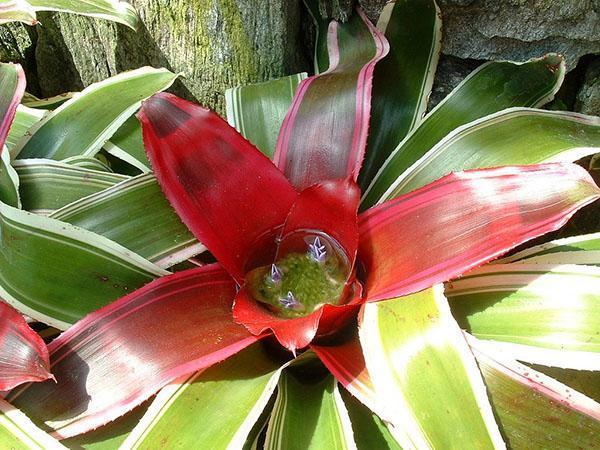Guzmania care at home
 Homeland Guzmania - tropical forests of South America, where plants prefer to settle on the trunks and roots of larger representatives of the flora. Today, an exotic culture is a popular indoor plant, and for many flower growers the question is relevant: "How to care for guzmania in a pot?"
Homeland Guzmania - tropical forests of South America, where plants prefer to settle on the trunks and roots of larger representatives of the flora. Today, an exotic culture is a popular indoor plant, and for many flower growers the question is relevant: "How to care for guzmania in a pot?"
What to consider when caring for guzmania at home?

First of all, attention is drawn to the funnel-shaped shape of the leaf rosette, designed not only to ensure photosynthesis, but also to collect rain moisture, all kinds of organic matter. The root system of the guzmans, like that of other epiphytes, is not very suitable for extracting nutrients from the soil. She is too weak and fragile, but these roots:
- they are excellently obtained from the air and a very small amount of the substrate that accumulates under the outlet and next to it;
- provide reliable attachment of the plant to the tree or its roots.
Unlike some epiphytes, which receive nutrition from the plant on which they live, guzmania is not a parasite and provides itself on its own.
An important feature of the culture is its long and unusual flowering. Although the flowers themselves cannot be called beautiful, and most often they are generally unobtrusive, for many lovers of decorative cultures, gusmania is a welcome guest in the home collection thanks to the bright stipules that crown the rosette for 3 to 4 months during flowering.
 Interest in exotic culture is great, but the natural features of the plant leave an imprint on its maintenance at home, on the care of the guzmania and maintaining its flowering.
Interest in exotic culture is great, but the natural features of the plant leave an imprint on its maintenance at home, on the care of the guzmania and maintaining its flowering.
How to care for potted guzmania?
 In order for the plant to feel comfortable in the house, it needs conditions close to those in which wild gusmania grows. The main requirements are:
In order for the plant to feel comfortable in the house, it needs conditions close to those in which wild gusmania grows. The main requirements are:
- in providing heat;
- in the absence of drafts;
- in regular, but not excessive watering;
- maintaining high humidity;
- in careful feeding throughout the entire period of active growing season.
In nature, under the canopy of a tropical forest, the plant is in warm air heated to 18–24 ° C. Only in winter does the temperature drop slightly, and during this period it will be comfortable for Guzmania to grow at 16-18 ° C. At the same time, the air humidity, especially in the summer months, is increased.
A video about caring for guzman at home will help to replenish the stock of knowledge about this interesting plant and preserve its decorative effect for a long time.
The best place for guzmania is where the plant is:
- will receive a bright but diffused light;
- will not be exposed to dry hot air coming from heating appliances;
- will be protected from cold winds and drafts.
The best location for a flower will be east or west windows. Not bad gusmania adapts in the depths of the heated loggia facing the south.
If in winter the air in the room is excessively dry, moderate irrigation of the leaf outlet is mandatory as part of caring for the guzmania at home. The same procedure is required for the plant in summer, when the temperature exceeds 28 ° C.
How to water guzmania?
 Gusmania is a plant of the tropics, which needs not only humid air, but also soil. In the spring, when the activity of the green pet increases, the culture is provided with both moderate watering and feeding. But at the same time, they carefully monitor that water does not stagnate in the pot and pallet, which threatens to cause rotting of the roots and base of the outlet.
Gusmania is a plant of the tropics, which needs not only humid air, but also soil. In the spring, when the activity of the green pet increases, the culture is provided with both moderate watering and feeding. But at the same time, they carefully monitor that water does not stagnate in the pot and pallet, which threatens to cause rotting of the roots and base of the outlet.
A plant that naturally receives moisture only from precipitation does not react in the best way to tap water and may even die from it. Therefore, before watering the guzmania, the water must be defended or passed through a softening filter. In addition, the owner of a tropical culture needs to know that in the summer, moisture is poured into the central part of the plant outlet. In the same way, crop feeding can be carried out.
 As fertilizers for guzmania, it is more correct to take balanced ready-made products for bromeliads or use fertilizers for home crops with a low nitrogen content. An excess of this element can be detrimental to the plant. It is undesirable for the top dressing to contain calcium nitrate and superphosphate.
As fertilizers for guzmania, it is more correct to take balanced ready-made products for bromeliads or use fertilizers for home crops with a low nitrogen content. An excess of this element can be detrimental to the plant. It is undesirable for the top dressing to contain calcium nitrate and superphosphate.
The water in the outlet is replenished as it is absorbed and evaporated, and once every two months it is completely drained and replaced with fresh water.
In winter, moisture from the outlet is removed in order to prevent decay of the base of the foliage. With proper watering, the leaves of the plant have a good tone, do not dry out and do not turn yellow for a long time.
How to transplant guzmania indoors?
Guzmania is sold already in bloom, so after purchase, the plant should not be transplanted immediately. It is better to do this in a couple of weeks, when the flower has acclimatized a little.
 To make the green pet comfortable, and caring for the gusmania, as in the photo, was simple and effective, you should choose a wide, but not deep pot.
To make the green pet comfortable, and caring for the gusmania, as in the photo, was simple and effective, you should choose a wide, but not deep pot.
A drainage layer is made at the bottom of the container, and a ready-made mixture for bromeliads is used as a substrate. You can pick up the soil yourself using:
- humus;
- peat;
- coarse sand;
- sod soil;
- loam.
The components are mixed in equal proportions, then chopped and steamed needles, sphagnum and small pieces of charcoal are added to the substrate for looseness and airiness.
 From an old pot to a new adult plant, they are transferred very carefully, trying to preserve all existing roots. The outlet is not buried, and the soil is carefully compacted after transplantation. Guzmania plants are incredibly attractive, which, as in nature, are planted in a recess on a driftwood, or used in a composition with bark or moss. In this case, the socket will have to be additionally fixed with wire until the roots of the guzmania are fixed and they cannot provide a strong position for the flower.
From an old pot to a new adult plant, they are transferred very carefully, trying to preserve all existing roots. The outlet is not buried, and the soil is carefully compacted after transplantation. Guzmania plants are incredibly attractive, which, as in nature, are planted in a recess on a driftwood, or used in a composition with bark or moss. In this case, the socket will have to be additionally fixed with wire until the roots of the guzmania are fixed and they cannot provide a strong position for the flower.
Unfortunately, the life of an adult outlet ends when the peduncle withers. But you shouldn't despair. If the care of the guzmania, as in the photo, is carried out correctly, the plants throughout their life retains the juiciness and splendor of the rosette, blooms and gives young shoots. At the base of a large rosette, small gusmanias usually appear, which are easy to plant as soon as they acquire their own roots. This is best done in the spring, when the seasonal awakening begins.
In order for the “kids” to grow faster and better, the peduncle that has begun to fade is cut off from an adult plant. Such a measure will save the guzmania's strength and will allow to obtain planting material of excellent quality.
From the moment the shoots appear until they bloom, at least 2-3 years should pass. At the same time, young guzmania will have to be artificially pushed to the formation of buds. To do this, the plant is transferred to a room where the temperature is raised to 26–27 ° C, and after a while, it is returned to its usual conditions.